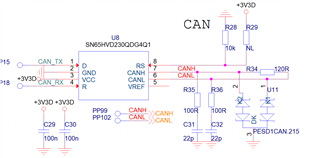Hi, everyone.
I have the next problem with SN65HVD230 CAN working, but when I check the signal on the oscilloscope for example only TX, I see strange signals.
Photo below split connection:
Standard connection:

Schemes were different. i tried different values for resistors and capacitors, and the result looks the same.
Sorry, i forgot the project on another PC, and the schemes i take from the forum. But they are very similar to the original.
Standard:
On split termination I had Rterm = 60R and Csplit = 4.7nF
With Kind regards,
Oleksii





